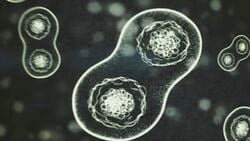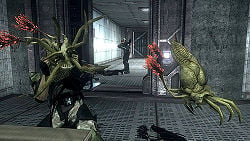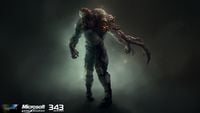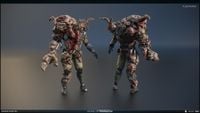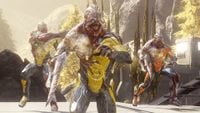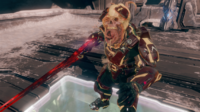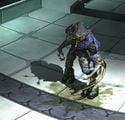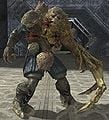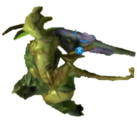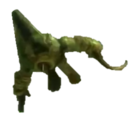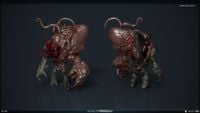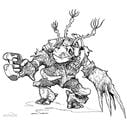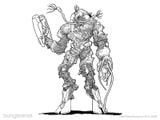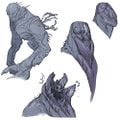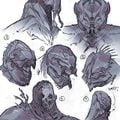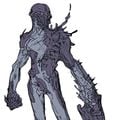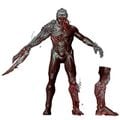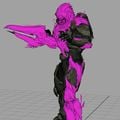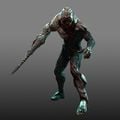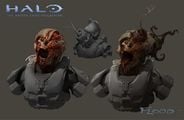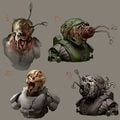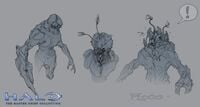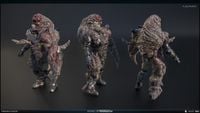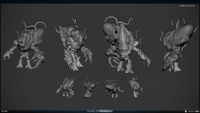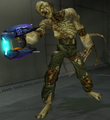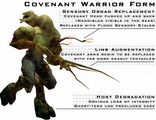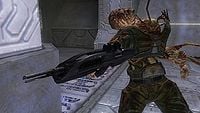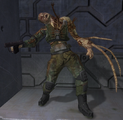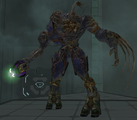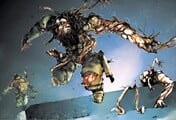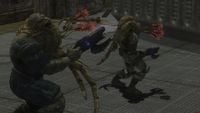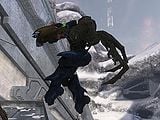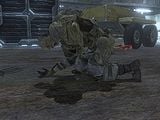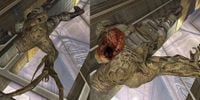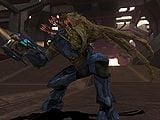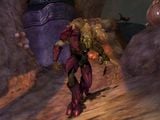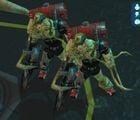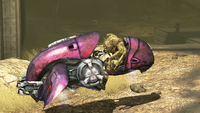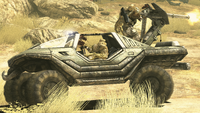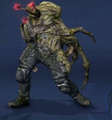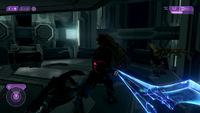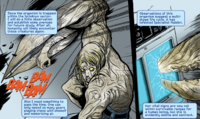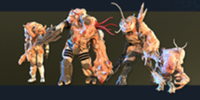Flood attacker form
From Halopedia, the Halo wiki
| Attacker form | |
|---|---|
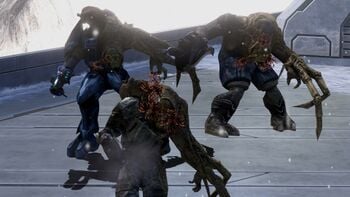 Sangheili, Jiralhanae, and human attacker forms | |
| General overview | |
|
Distinctions: |
Host body covered with greenish-gray decaying skin and armed with mutated appendages. The host's head is pushed aside to make room for the pod infector.[1] |
|
Method of attack: |
Lunging at a victim, whipping with appendages and using held weapon.[1][2] |
|
Notable individuals: |
|
- "Knowing that monster firing a Battle Rifle at you used to be Kevin from 2nd Platoon is just creepy. That could be me."
- — Specialist Archibald Berger, 6th Airborne Division, UNSC Army[3]
Attackers are the most basic kind of Flood combat form, serving as the parasite's primary combatants. While combat forms can be created from both sapient and non-sapient hosts, attackers are solely formed via the infection of sapient victims. This is accomplished through exposure to the Flood Super Cell, generally via a pod infector.[2] Attacker forms are commonly referred to simply as combat forms, as the other combat form variants are significantly more uncommon during Flood outbreaks.
Pathology
Infection and creation
Like other combat forms, attackers are typically created when a pod infector burrows into a host,[4] though this can also be caused by spores or other microbiological vectors entering the host body.[4] As attacker forms naturally produce the Flood Super Cell (or FSC), even coming into contact with one can result in infection for an unprotected potential host. Given the combat forms' preference for melee combat, this makes even non-fatal strikes a death sentence, though such infections may progress slowly.[5] However, infection by spore inhalation or infection form is extremely quick, with a host succumbing often in as little as a few seconds.[1]
When infected by a pod infector, the infector latches onto the host and dig into the host's flesh with a razor-sharp barb-like appendage, injecting the FSC. Typically, the pod infector burrows itself into the chest cavity of the host. As it gains control of the host and tranforms it into an attacker form, the pod infector will dislodge any bones and organs to make room for itself, resulting in extreme pain and disfiguration such as dislocating the host's jaw or,[6] in the case of infected Sangheili, completely snapping their necks. This process can be performed on living or recently-deceased hosts, though often results in the "death" of a living host prior to their re-animation once the FSC takes hold.[4] Some hosts may be attacked and infected by multiple pod infectors.[7] Even if the infection form is removed, the injection of FSC into the victim's bloodstream results in those wounds becoming spore-filled blisters, and the host cannot be saved from infection.[8]
Once the sapient host is infected, the FSC begins to consume and convert sections of the host body, creating growths and new appendages formed by the FSC itself. These growths appear randomly, and appendages produce whip-like tentacles that can be used by the attacker form for striking enemies. As this process occurs, bodies take on the appearance and smell of decay.[7] Some limbs and sensory organs are preserved in the transformation, and are used to operate tools, equipment, weapons, vehicles, and even ships.[2] Infection forms will often augment a host's body to better serve as a living weapon, and damage taken during fighting and infection can be repaired by the controlling infection form, though the attacker form is ultimately disposable.[9][2] Any damage that the attacker form receives ultimately creates more vectors of infection as the chunks of infect flesh it leaves behind are scattered throughout the environment.[2] The FSC is able to arrange itself to mimic any organ needed to keep the host working,[10] while other internal organs are replaced with accretions containing a sickly green liquid full of spores in suspension. Spore-filled polyps also often cover the exterior of attacker forms.[2] Even once the FSC has taken control of the victim, the controlling infection form can often be seen buried within the victim, with the infection form's red sensory appendages poking out of the flesh. Until the body is completely subsumed by super cell growth, these appendages are maintained as an impromptu central nervous system.[4][2] Some attacker form super cell growths may take on a more chitinous appearance, akin to armor plating, helping protect to the attacker form from enemy retaliations.[11]
Attacker forms can be created from living or recently deceased hosts, though the infection process typically kills living hosts. Regardless, the process of infection and reanimation is extremely painful and victims writhe in pain as the Flood takes control irrespective of if they were previously dead or not.[1] The victim may still attempt to cry out from what remains of its mouth and throat even while being controlled, though it is also possible for the infection form to do so using the host's thoughts and memories as a psychological weapon.[12] In some circumstances, a victim may remain fully aware of their present status, unable to do much but watch as their body is controlled by an outside force.[9][2]
In the case of Private Wallace Jenkins, an infection form had been weakened by eons of stasis and failed to completely take over Jenkins' body as it tried to create an attacker form. As a result, the Marine was able to watch and listen as his body was driven to try and kill or infect those he once considered allies. Jenkins described the presence of the infection form controlling his body as the "other," a strange being without any thoughts and seemingly unaware that the host consciousness was still active inside its body.[13] Jenkins was able to retain a limited amount of motor control of his body, and was able to mime a request for a mirror while in captivity, though the infection form was also able to take back control to attack the Marines surrounding him.[7]
Capabilities
The infection form controlling an attacker does not feel pain or fear, though the host is able to feel the physical effect of attacks rendered upon it if they are still conscious.[9] In extreme cases, the infection form will resort to self-mutilation of the host body if it needs to, such as breaking its own arms to use the snapped bone as an impromptu weapon. However, in an isolated case, pain inflicted on the host body has been observed to weaken the controlling infection form. However, this may have been a result of the unique circumstances of Private Jenkins' infection and not representative of all attacker forms.[7] The attacker form is reliant on the infection form for all bodily and motor functions, and shooting the infection form will "kill" the attacker form, though the body can be re-reanimated if another infection form is able to reach it. As such, an attacker form can be resurrected as many times as is needed, provided that enough of the body remains intact. To properly kill an attacker form, it must be dismembered or disfigured to the point at which it is no longer a suitable host body for an infection form. This can be accomplished through the use of explosive force, gravitic blasts such as those from a gravity hammer, cutting the body up with a weapon such as an energy sword or combat knife or simply incinerating it with plasma or fire.[1]
Once infected, the infection form is able to absorb all of the host's knowledge and memories, a trait which makes attacker forms particularly dangerous. Because of this, they are capable of operating the same firearms, vehicles, tools, and even starships that their host was familiar with.[9] During the outbreak on the Infinite Succor in 2552, infected warriors were able to set up patrols of the ship's corridors to guard the Proto-Gravemind growing in the ship.[14] The Flood's possession of an individual's body allows it to speak with the host's tongue.[9][14][15] This memory-absorption extends critical knowledge such as command codes or colony locations. As such, when critical personnel are infected, they are contributed to the construction of a Gravemind.[16]
In combat, attacker forms use their whip or scythe-like growths to attack their opponents in melee combat, and are capable of performing impressive feats such as leaping large distances to cover ground. Even if a melee strike is not fatal, the imparted Flood Super Cell is enough to ensure the target's infection and death.[5] As the infection forms do not typically feel pain, attacker forms are undeterred by enemy attacks and will not stop until they are destroyed, or their enemy is killed. Ballistic weapons are notably less effective against attacker forms because of this, with SRS99C-S2 AM sniper rifle rounds passing through attacker forms with virtually no effect.[17] Targeted shots against the limbs and embedded infection form are effective ways of neutralizing attacker forms.[18]
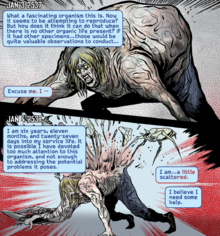
Role within the Flood
Attacker forms make up the majority of the Flood's combatant forces, particularly during the Feral Stage of the parasite's development when it has yet to acquire enough raw biomass for the creation of a Gravemind or pure forms. During this stage, attacker forms are not centrally controlled, and will begin to gather bodies for conversion into more Flood forms.[16]
When a local biosphere has been completely assimilated into the Flood, typically once the Flood has entered the Coordinated Stage, new attacker forms cannot be created due to a lack of viable hosts. Because of this, the Flood moves onto breaking down raw biomass into Flood Super Cell, thereby creating pure forms wholly from collected biomass. Once the number of pure forms reaches a sufficient equilibrium, existing attacker forms are relegated to defensive roles or added to the hive's raw biomass and calcium reserves.[10] Otherwise, aging or damaged attacker forms eventually turn into carrier forms, growing infection forms within a large, bulbous mass on their back.[4][19]
Kinds of attacker forms
Human form
The human attacker form is significantly smaller than other forms due to their hosts' smaller stature. As with other combat forms, it is capable of sustaining massive physical damage before being unusable to the Flood. Although they cannot take as much damage as attacker forms created from larger hosts, human attacker forms have some advantages. They are more agile, smaller targets, and have quicker reflexes in combat. During the infection process, the head of the attacker form is pushed to one side of the body to make room for the pod infector.[1]
A human attacker form in Halo 3.
Concept art of a human attacker form for Halo Wars made canon in the Halo Encyclopedia (2022 edition).
A human attacker form in Halo: Combat Evolved Anniversary's terminals.
Human attacker form models for Halo Wars 2.
Spartan form
While no actual examples of Flood-infected Spartans are known to have existed, the UNSC Infinity's War Games combat training deck features simulations of Spartan-IV attacker forms, which may have been based on conjecture or on information from actual encounters.[20][21] Some Spartan-IV personnel volunteer for assignment to Flood containment Fireteams, who have routinely dealt with Flood outbreaks in the Post-Covenant War conflicts. Should a Spartan become infected by the parasite, UNSC cryptonym CORRUPTER is declared, authorizing weapons of mass destruction for immediate release.[22]
Spartan-IV attacker forms bear several differences from standard human attacker forms. The right arm is converted into a pincer-like, bladed appendage, and the left leg sustains similarly drastic mutations. Exposed parts of the body are covered with what appear to be calcareous plates, and red "muscle" tissue can be seen in the gaps between plates. A large hump or tumor-like growth on the back is apparent, perhaps serving to shield the pod infector. Perhaps because of the obstructing bodysuit, the typical Flood sensory tentacles do not protrude from the chest cavity. The form appears to retain more of the host's original silhouette than typical attacker forms. Although most of the Spartan's armor is discarded, the components responsible for generating the energy shield are retained.[20] UNSC War Games have also simulated infected Spartan-II personnel, featuring mostly intact armor plating except for the neck and head region, where the helmet is cracked and the remains of the victim's skull are visible. These infected SPARTAN-IIs have large Flood biomass growth around their head, with their jaws dislocated to allow the emergence of a Flood tendril.[21]
Sangheili form
The Sangheili attacker form is agile, resilient, and capable of utilizing its host's armor abilities such as active camouflage and energy shields to assist them in combat. The head of the attacker form is typically slung over the shoulder, the neck bones having been broken during infection.[1]
A Sangheili attacker form in Halo 2.
A Sangheili attacker form in the Halo Graphic Novel.
Jiralhanae form
The Jiralhanae attacker form is a formidable enemy and is more aggressive in combat than other attacker forms, as it will charge towards an opponent recklessly, a holdover from the Jiralhanae's savage nature and preference for close combat. However, it is bulkier and slower than other attacker forms. During infection, the pod infector often burrows into the mouth of a Jiralhanae, pushing the lower jaw and rest of the head apart to fit into the body. This is in contrast to the infection process of humans and Sangheili, where the pod infector typically burrows into the chest of its victim.[1]
Kig-Yar form
The Kig-Yar attacker form is rarely seen as infected members of the species are commonly converted into carrier forms or processed for their biomass. These building blocks can be used to add to a Gravemind's superstructure or be molded into Flood pure forms.[citation needed] However, Kig-Yar attacker forms were witnessed during the Battle of Trove in 2531.
Unggoy form
The Unggoy attacker form is also rarely seen for the same reason as Kig-Yar attacker forms. Unggoy are generally used to create carrier forms or transformed into biomass that can be contributed to the expansion of a Gravemind or the creation of pure forms.[citation needed] Unggoy attacker forms been witnessed on two occasions, during both the Battle of Trove and the Second Ark Conflict.
Forerunner form
Forerunner attacker forms were described as sickly green with a blotchy hide and long limbs. Remnants of the host's armor could still be found lodged in the attacker form.[23]
Gameplay
- Attacker forms can take extensive and sizable amounts of damage before being neutralized. Arms, legs and even heads can be dismembered before they are incapacitated. The weak areas of an attacker form are its sensory appendages that normally develop on the upper chest. This is where the pod infector has nestled, and the body is incapacitated if this area is destroyed by a projectile weapon.
- In Halo: Combat Evolved, an attacker form may fall only to stand up again and keep fighting. This can only happen if it is not damaged enough. In Halo 2 and Halo 3, if the body is not destroyed, attacker forms can be revived if another pod infector crawls into it.
- Human weapons are generally more effective against the Flood, as Covenant plasma weaponry is designed to debilitate targets by causing burning pain and structural damage to bodies, and the Flood cannot feel pain or be crippled.[24] However, In Halo 3, plasma-based weaponry and melee attacks, formerly weak against the attacker forms in the previous two games, are now highly effective. Piercing weapons such as the Sniper Rifle and the Beam Rifle have little effect on attacker forms, as both are designed to cause damage to internal organs, which the attacker form does not require. At a distance, explosive ordnance such as grenades, rockets, and fuel rod gun projectiles, and ranged weapons such as the Battle Rifle or the Covenant Carbine can perform well against attacker forms. Do note that Plasma and Spike grenades should be used with caution, as the attacker form will sometimes ignore all other targets and charge players using such weapons at high speed. The Needler can be devastating, as the supercombine explosion will prevent it coming back to life in Halo: Combat Evolved, and will shatter it in Halo 2 and 3. In addition, the Needler's explosions will destroy an entire horde of charging Flood attacker forms, similar to grenades and rocket launchers, minus the chance of self-injury. For ranged weapons, it is recommended for players to focus their fire at the sensory appendages that are visible on attacker forms as successfully firing at one will immediately bring down an attacker form. Dismemberment with ranged weapons is also recommended to prevent attacker forms from firing their held weapons. At close combat, it is recommended that individuals acquire close-quarters weapons such as the Shotgun, Energy Sword and Gravity Hammer as they perform exceptionally well against attacker forms. The melee attacks from the Brute Shot and Spiker will also do impressively well, no doubt due to the large bayonets that each weapon possesses. Burning attacker forms with sufficient amounts of heat (such as that generated by the Sentinel Beam) is one of the most effective methods in any situation, as is the destruction of the torso. Automatic weapons are also effective, though ammo inefficient (it can take up to an entire magazine of assault rifle ammunition to kill a single attacker form).
Trivia
General
- In Halo: Combat Evolved, attacker forms will not disintegrate from successive melee hits when they are dead like in Halo 2 and Halo 3.
- In Halo 2, all attacker forms are also capable of driving and boarding vehicles and are able to do so in Halo 3, though the ability to drive vehicles is lost. They still retain the ability to board slow moving vehicles however.
- In Halo 2, all of the Sangheili forms encountered use one armor palette; the Minor Combat Harness. In Halo 3 however, the Sangheili Forms will retain its host's armor palette. Strength of each Sangheili Form will be dependent on the ranks of its host; an infected Sangheili Major will be considerably harder to kill than a Sangheili Minor. Killing a Sangheili attacker form is often more difficult than killing a human or Jiralhanae attacker form, due to the fact that the infected Sangheili often retain their personal energy shielding.
- Flood attacker forms seem to take on physiological and biological changes throughout the Halo trilogy; these changes from game to game could be due to the Gravemind's influence in attempting to create a better Flood soldier or they could simply be graphical updates.
- While most Flood attacker forms wield the weapons of their host's former species, it is not uncommon to encounter them using weapons that their hosts never could have or would have used - human forms with Covenant weapons, Sangheili forms with Jiralhanae weapons, Jiralhanae with human weapons, and many other strange combinations exist, all of which would be rare for their 'living' counterparts.
- In all of the Halo games, Flood attacker forms always hold certain two-handed weapons with one hand, and can actually reload them without doing a reload animation. These weapons include the Shotgun, the Rocket Launcher, the Assault Rifle and others. They can also use the Magnum with one hand and reload it without doing any animation for it. While never shown, it is entirely possible that, in the case of the shotgun, that the flood created a "tentacle" that extended from the host's forearm to pump the weapon.
Halo: Combat Evolved
- Attacker forms will run towards the player when armed. Both human attacker forms and Sangheili attacker forms will berserk when they have their arm that holds a gun shot off and will rush the player. Attacker forms that are unarmed will rush the player by default.
- Sangheili attacker forms can have their head and arms shot off while human attacker forms can have their head, arms and chest cavity shot off.
- In the campaign level 343 Guilty Spark, if you stand on a light bridge, the Flood attacker forms will leap onto the bridge and get stuck. They will only be able to move by jumping at you.
- If you shoot both arms off an attacker form in Halo: Combat Evolved it will not be able to attack you and will simply follow you around. Players have dubbed this instance as creating a "Flood Buddy".
- This is the only game in which a pod infector cannot revive a dead attacker form; instead they may just get back up.
- Striking an attacker form with a vehicle (even a small touch) will result in an instant kill. This is due to the game's physics engine, where a collision with a moving vehicle would kill characters instantly, regardless of the vehicle's speed.
- All human attacker forms are barefoot. This is strange because they wear shoes in Halo 2 and Halo 3. This may however been a design choice to make them look menacing.
Halo 2
- When using the Grunt Birthday Party skull against the Flood in Halo 2, the effect of the skull will cause the plasma grenade explosion to occur when you shoot the attacker form in the chest, where the pod infector is.
- Reflecting their enhanced intelligence, human attacker forms still wear the armor they had on when they first transformed making it significantly harder to shoot the pod infector in their chest. Sangheili attacker forms can now often have shields which recharge over time. Once the shield is taken down, though, they are very easy to incapacitate.
- The attacker form's performance in close quarters combat has improved. They now attack much faster than in Combat Evolved, deal more damage and can hit enemies behind them with a backwards melee strike. If their tentacled arm is shot off and they don't wield a weapon in their other hand, they will try and melee enemies with their remaining arm, however this attack does no damage.
- The attacker form can sprint towards enemies at a distance (unable to shoot while sprinting).
- In Halo 2, Flood attacker forms can be disintegrated, leaving only pieces of their limbs and shards of armor. This occurs if an attacker form is hit by an Energy Sword, blown up by grenades, after many successive melee attacks, if splattered by a fast-moving vehicle, if both of its arms are shot off or if the attacker form falls far enough to hit a death barrier.
Halo 3
- Attacker forms can pick up any weapon should it be near them when they "resurrect". They will also pick up two handed weapons such as the Plasma Cannon and Flamethrower if close by. Like other weapons, they will wield it with only one hand.
- Probably to prevent the player from getting a big combat advantage from Jiralhanae attacker forms during the brief time they are allies in The Covenant, or perhaps to prevent enemy Flood attacker forms from overwhelming the player, weapons that would normally be picked up when a Jiralhanae attacker form "resurrects" are deleted by the game's code, rendering them unusable.
- An infected Jiralhanae Chieftain will turn into the generic Jiralhanae attacker form character model, which is used for all Jiralhanae that become infected, regardless of rank or armor type. This is a pattern shown throughout the games; attacker forms are all portrayed with a singular generic character model, depending on the species that is infected.
- The Jiralhanae attacker form is the only attacker form in Halo 3 which the host's original head cannot be shot or meleed off.
- Regardless of gender, an infected human becomes a male attacker form. There are no variations between an infected male or female Marine, because there is only one character model for the human attacker form in the game.
- Attacker forms are capable of speech in an echoing voice. They usually speak for the Gravemind or quote their host.
- Halo 3 is the only game in which an attacker form can be killed instantly by meleeing them with something other than an Energy Sword, gravity hammer or Brute Shot.
- It is far easier to disintegrate attacker forms in Halo 3. Often one or two melee strikes is enough to disintegrate them, compared to the upwards of a dozen successive melee hits required to achieve the same effect in Halo 2.
- Any attacker forms that is killed without being disintegrated can be revived by pod infectors. The best way to discourage this is to always destroy the bodies.
- It is noted that using the Flamethrower against pure forms is more effective than attacker forms. Pure forms will die almost instantly from the flames, while attacker forms may charge at the player while its still on fire.
Halo: Combat Evolved Anniversary
- Human attacker forms receive a graphical update while Sangheili attacker forms appear to be using the models from Halo 3. This is most noticeable at the legs, which do not end with Halo: Reach-styled feet. Additionally, all the Sangheili forms appear to be Ultras.
Halo 2: Anniversary
- Both human and Sangheili attacker forms retain much of their host armor. Human forms have the body armor of former UNSC Marines while Sangheili forms all have Minor Elite combat harnesses, much like in the original game.

|
Browse more images in this article's gallery page. |
Gallery
Development images
Early concept art of attacker forms for Halo: Combat Evolved.
Early concept art of an Unggoy attacker form for Halo: Combat Evolved.
Concept art of the Spartan-IV attacker form in Halo 4.
Concept art of an infected Spartan for Halo 2: Anniversary.
Screenshots
A human attacker form in Halo 2.
Two human attacker forms in Halo Graphic Novel: Breaking Quarantine.
A Marine transforming into an attacker form after getting infected by a pod infector in Halo 3.
A human attacker form driving a Karo'etba-pattern Ghost in the Halo: The Master Chief Collection version of Halo 3: ODST.
A horde of attacker forms onboard the prison ship Mona Lisa.
A human attacker form in Halo: Combat Evolved Anniversary.
Render of a Sangheili attacker form in Halo: The Master Chief Collection.
Thel 'Vadam battling Sangheili attacker forms on the Threshold gas mine in Halo 2: Anniversary.
A comparison between a Spartan attacker form and an unknown Flood form on Lockdown.
A human attacker form in Something has Happened.
List of appearances
- Halo: Combat Evolved (First appearance)
- Halo: The Flood
- Halo 2
- Halo Graphic Novel
- Halo 3
- Halo Wars
- Halo 3: ODST (Halo: The Master Chief Collection-only)
- Halo Legends
- Halo: Evolutions - Essential Tales of the Halo Universe
- Halo: Combat Evolved Anniversary
- Halo 4
- Halo: Spartan Assault
- Halo 2: Anniversary
- Halo: Fractures
- Halo: Tales from Slipspace
- Halo Wars 2
- Halo: Fireteam Raven
Sources
- ^ a b c d e f g h Halo 3, Gameplay
- ^ a b c d e f g h Halo Encyclopedia (2022 edition), page 408
- ^ Halo: Spartan Assault: Flood missions, Quotes
- ^ a b c d e Halo Waypoint, Flood (Retrieved on Jun 1, 2020) [archive]
- ^ a b Halo: Evolutions - The Mona Lisa
- ^ Halo 2: Anniversary, Infection game mode
- ^ a b c d Halo: The Flood, chapter 10
- ^ Halo Wars 2, Phoenix Logs: Infection Forms
- ^ a b c d e Halo Wars 2, Phoenix Logs: Combat Forms
- ^ a b Halo 3, Bestiarum
- ^ Halo 4, Flood gametype
- ^ Halo Wars 2, Phoenix Logs: Infected
- ^ Halo: The Flood, chapter 9
- ^ a b Halo Graphic Novel: The Last Voyage of the Infinite Succor
- ^ Halo 3, campaign level The Covenant
- ^ a b Halo: Combat Evolved, campaign level Keyes
- ^ Halo: Combat Evolved, Gameplay
- ^ Halo: Official Spartan Field Manual, page 172-175
- ^ Halo Encyclopedia (2022 edition), page 409
- ^ a b Halo 4, multiplayer - Flood gamemode
- ^ a b Halo 2: Anniversary, multiplayer - Infection game mode
- ^ Halo: Official Spartan Field Manual, PART 09: ALIEN FACTIONS, The Flood (p. 172-175)
- ^ Halo: Fractures, Defender of the Storm, page 231
- ^ Halo: Evolutions - Essential Tales of the Halo Universe - The Mona Lisa
| |||||||||||||||||||||||||||||||||
